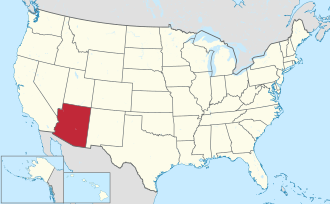Top Qs
Timeline
Chat
Perspective
Pinal County, Arizona
County in Arizona, United States From Wikipedia, the free encyclopedia
Remove ads
Pinal County is a county in the central part of the U.S. state of Arizona. According to the 2020 census, the population of the county was 425,264,[2] making it Arizona's third-most populous county. The county seat is Florence. The county was established in 1875.
Pinal County contains parts of the Tohono Oʼodham Nation, the Gila River Indian Community and the San Carlos Apache Indian Reservation, as well as all of the Ak-Chin Indian Community.
Pinal County is included in the Phoenix–Mesa–Chandler, Arizona Metropolitan Statistical Area. Suburban growth southward from greater Phoenix has begun to spread into the county's northern parts; similarly, growth northward from Tucson is spreading into the county's southern portions. Pinal County has five cities: Maricopa, Casa Grande, Apache Junction, Eloy, and Coolidge. There are also many unincorporated areas, which have shown accelerated growth patterns in recent years; such suburban development is likely to continue for the foreseeable future.
Remove ads
History
Pinal County was carved out of neighboring Maricopa County and Pima County on February 1, 1875, during the Eighth Legislature. In the August 18, 1899, issue of The Arizona Magazine, the name "Pinal" is said to come from the pine-clad Pinal Mountains.[3] Pinal County was the second-fastest-growing county in the U.S. between 2000 and 2010.[4]
In 2010, CNN Money named Pinal County as the second fastest growing county in the USA.[5]
Remove ads
Geography


According to the United States Census Bureau, the county has a total area of 5,374 square miles (13,920 km2), of which 5,366 square miles (13,900 km2) is land and 8.6 square miles (22 km2) (0.2%) is water.[6]
Mountain ranges
Adjacent counties
- Maricopa County – west, north
- Gila County – north
- Graham County – east
- Pima County – south
Major highways
National protected areas
Remove ads
Demographics
Summarize
Perspective
2020 census
2010 census
As of the census of 2010, there were 375,770 people, 125,590 households, and 92,157 families living in the county.[15] The population density was 70.0 inhabitants per square mile (27.0 inhabitants/km2). There were 159,222 housing units at an average density of 29.7 units per square mile (11.5 units/km2).[16] The racial makeup of the county was 72.4% white, 5.6% American Indian, 4.6% black or African American, 1.7% Asian, 0.4% Pacific islander, 11.5% from other races, and 3.8% from two or more races. Those of Hispanic or Latino origin made up 28.5% of the population.[15] In terms of ancestry, 16.9% were German, 10.6% were Irish, 9.5% were English, and 2.8% were American.[17]
Of the 125,590 households, 37.0% had children under the age of 18 living with them, 55.8% were married couples living together, 11.7% had a female householder with no husband present, 26.6% were non-families, and 20.5% of households were made up of individuals. The average household size was 2.78 and the average family size was 3.21. The median age was 35.3 years.[15]
The median household income was $51,310 and the median family income was $56,299. Males had a median income of $45,082 versus $34,785 for females. The per capita income for the county was $21,716. About 10.1% of families and 13.5% of the population were below the poverty line, including 18.3% of those under age 18 and 7.6% of those age 65 or over.[18]
2000 census
As of the census of 2000, there were 179,727 people, 61,364 households, and 45,225 families living in the county. The population density was 34 inhabitants per square mile (13 inhabitants/km2). There were 81,154 housing units at an average density of 15 units per square mile (5.8 units/km2). The racial makeup of the county was 70.4% White, 2.8% Black or African American, 7.8% Native American, 0.6% Asian, 0.1% Pacific Islander, 15.7% from other races, and 2.7% from two or more races. 29.9% of the population were Hispanic or Latino of any race. 21.9% reported speaking Spanish at home, while 1.4% speak O'odham and <0.1% speak Apache.[19]
Of the 61,364 households 29.8% had children under the age of 18 living with them, 56.9% were married couples living together, 11.5% had a female householder with no husband present, and 26.3% were non-families. 21.1% of households were one person and 9.2% were one person aged 65 or older. The average household size was 2.68 and the average family size was 3.09.
The age distribution was 25.1% under the age of 18, 8.7% from 18 to 24, 27.3% from 25 to 44, 22.7% from 45 to 64, and 16.2% 65 or older. The median age was 37 years. For every 100 females, there were 114.2 males. For every 100 females age 18 and over, there were 117.0 males.
The median household income was $35,856 and the median family income was $39,548. Males had a median income of $31,544 versus $23,726 for females. The per capita income for the county was $16,025. About 12.1% of families and 16.9% of the population were below the poverty threshold, including 25.5% of those under age 18 and 8.7% of those age 65 or over.
Remove ads
Politics
Summarize
Perspective
During the 20th century, Pinal was very much a bellwether county in U.S. presidential elections, having supported the winning candidate in every election between Arizona's statehood in 1912 and 2004 except for that of 1968, when Hubert Humphrey won the county by 3.2 percentage points but lost to Richard M. Nixon. As a result of the urban sprawl from Phoenix spreading into the county, a major political reversal has taken place between it and neighboring Maricopa County since the turn of the millennium. Maricopa County is now becoming more progressive as is the trend of most largely populated city centers in America. Pinal voters trend more conservative. In 2024, Donald Trump carried the county by the largest margin for a Republican since statehood. The county is one of the most conservative suburban areas outside of the deep South, and one of the few that has continued to trend rightward in the Trump era.
Remove ads
Government
Salaries for county elected officials are set by the Arizona Revised Statutes. All county elected officials except the Sheriff (Ross Teeple as of 2025[22]) and the County Attorney make a salary of $63,800, along with county benefits and compulsory participation in the Arizona State Elected Official Retirement Plan.[23] In 2020, the Republican Party won complete control of the Board of Supervisors. In 2022, the Arizona Supreme Court deemed their Road Improvement Tax (passed in 2018) as illegal due to the tax only applied to purchases under $10,000. In 2022, the county's elections department came under intense scrutiny following several mistakes in the primary election. At the time, the Elections Department had only two full-time employees. The Board of Supervisors found themselves being accused of not properly funding the Elections Department.
Remove ads
Economy
CoreCivic, while still known as Corrections Corporation of America, operated the privately owned Saguaro Correctional Center.[24] located in Eloy in Pinal County,[25] It is paid by the state of Hawaii to house the majority of Hawaii's male prison inmate population.[24][dead link]
Communities


Cities
- Apache Junction (partially in Maricopa County)
- Casa Grande
- Coolidge
- Eloy
- Maricopa
Towns
- Florence (county seat)
- Hayden (partially in Gila County)
- Kearny
- Mammoth
- Marana (mostly in Pima County)
- Queen Creek (partially in Maricopa County)
- Superior
- Winkelman (partially in Gila County)
Census-designated places
- Ak-Chin Village
- Arizona City
- Blackwater
- Cactus Forest
- Campo Bonito
- Casa Blanca
- Chuichu
- Dudleyville
- Gold Canyon
- Goodyear Village
- Kohatk
- Lower Santan Village
- Oracle
- Picacho
- Queen Valley
- Red Rock
- Sacate Village
- Sacaton
- Sacaton Flats Village
- Saddlebrooke
- San Manuel
- Santa Cruz
- San Tan Valley
- Stanfield
- Stotonic Village
- Sweet Water Village
- Tat Momoli
- Top-of-the-World (partially in Gila County)
- Upper Santan Village
- Vaiva Vo
- Wet Camp Village
Other unincorporated communities
Ghost towns
County population ranking
The population ranking of the following table is based on the 2020 census of Pinal County.[26] † county seat
Remove ads
See also
References
External links
Wikiwand - on
Seamless Wikipedia browsing. On steroids.
Remove ads




